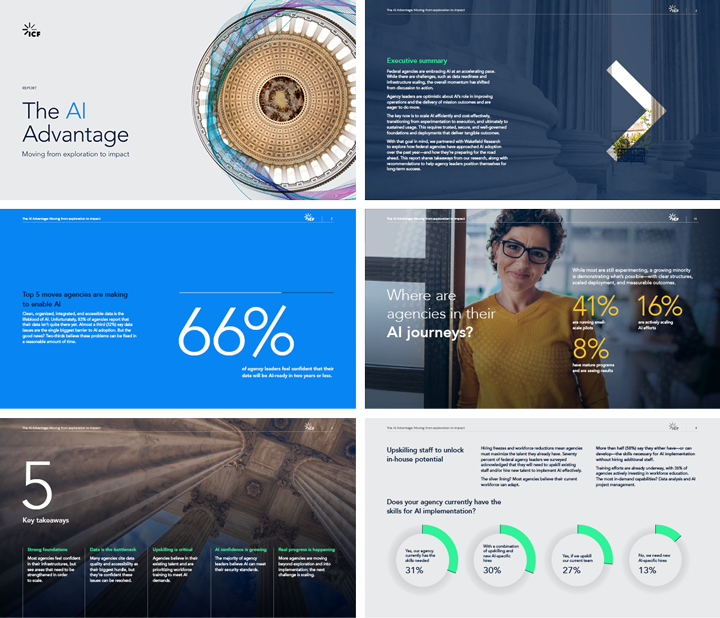
How the ‘Voice of the Client’ delivers value
This is the third in a three-part series about the value of human-centered design in government agency digital modernization.
The first two posts in this series explored how the Voice of the Client (VoC) shapes our human-centered design (HCD) approach and drives efficiency and innovation throughout the design and development process. In this post, we’ll examine how the outcomes of that process can deliver measurable financial value for agencies—and how VoC-driven design lays a solid foundation for seamlessly integrating AI-powered services without disrupting the overall application experience.
Let’s revisit the agency client from the previous posts. We worked with this client to modernize a two-decade-old system, replacing it with a new modernized system. As mentioned in the previous article, there was a focus on keeping the UX aligned to three goals: simplicity, consistency, and accessibility. We applied these same guiding principles to the overall solution architecture, resulting in a cloud-based system built on open-source software that meets all security and business requirements. This approach also enabled the team to develop a platform that can evolve over time—without costly licensing fees or dependence on proprietary solutions.
This approach ultimately benefits the client by freeing the agency from dependence on proprietary vendor solutions that can constrain roadmaps and shift priorities. With control over the platform, the agency sets its own direction. Future enhancements become more cost-effective, while strengthening the agency’s ability to deliver on its mission. The resulting system is built to scale rapidly, enabling the agency to quickly respond to evolving business needs and seize new opportunities.
For example, when the client requested a workflow enhancement to manage returned mail from address changes affecting thousands of users, we developed and deployed the update in under two days. After implementation, the client reported an 86% reduction in time and resources compared to the previous process. As the client grows more familiar with the service they helped design, their ideas continue to evolve—shaped by a clearer understanding of what the platform can deliver. This feedback loop is powered by a flexible, scalable architecture and grounded in a deep understanding of the Voice of the Client (VoC). By designing the system collaboratively, we ensured the experience aligns with the client’s business needs, enabling the agency to stay focused on mission priorities. The result: faster iteration, lower development effort, and a stronger return on investment.
“Integrating human-centered design with Agile-driven requirements and analysis methods has delivered top-tier results for ICF and our clients. This ongoing collaboration ensures that each iteration is increasingly aligned with user needs and expectations, driving continuous improvement and innovation throughout the development process.”
Modernization that delivers value today—and tomorrow
Adhering to the Voice of the Client (VoC) is about more than just creating an appealing user interface; it's about building flexible systems that can evolve with technological changes, particularly as artificial intelligence becomes integrated into application design. AI can help us create systems that anticipate user needs, offering proactive solutions, streamlining workflows, and enhancing user satisfaction.
When the VoC is embedded into the design, AI brings immediate benefits, such as:
- Predictive analytics: AI can forecast user behaviors and needs, enabling systems to adjust dynamically in real time.
- Personalization: By learning individual preferences, AI customizes user interfaces to enhance engagement and usability.
- Automation: AI can automate routine tasks, freeing users to focus on higher-value work.
As an example, we partnered with the agency to transform their paper notifications into digital communications, achieving a remarkable 97% reduction in operational costs and a 59% open rate within just one day of receipt of notification. While these results were impressive, the true potential of this transformation could be further unlocked with AI-powered VoC insights:
- AI can analyze user feedback to pinpoint issues (like unclear subject lines) and identify preferred communication channels.
- AI can enable continuous improvement by refining templates and timing based on real VoC data, boosting engagement.
- Sentiment analysis can detect negative trends (e.g., complaints about frequency), empowering the agency to adjust quickly.
- Real-time VoC insights allow for personalized notifications tailored to each user’s needs, such as sending relevant reminders and alerts.
Ultimately, the success of AI-driven service modernization depends on listening to real user feedback and adapting to their needs. VoC isn't just a feature; it’s the foundation for building future-ready services. Agencies that integrate VoC and AI will not only stay competitive but lead in delivering smarter, more responsive, and impactful user experiences.
